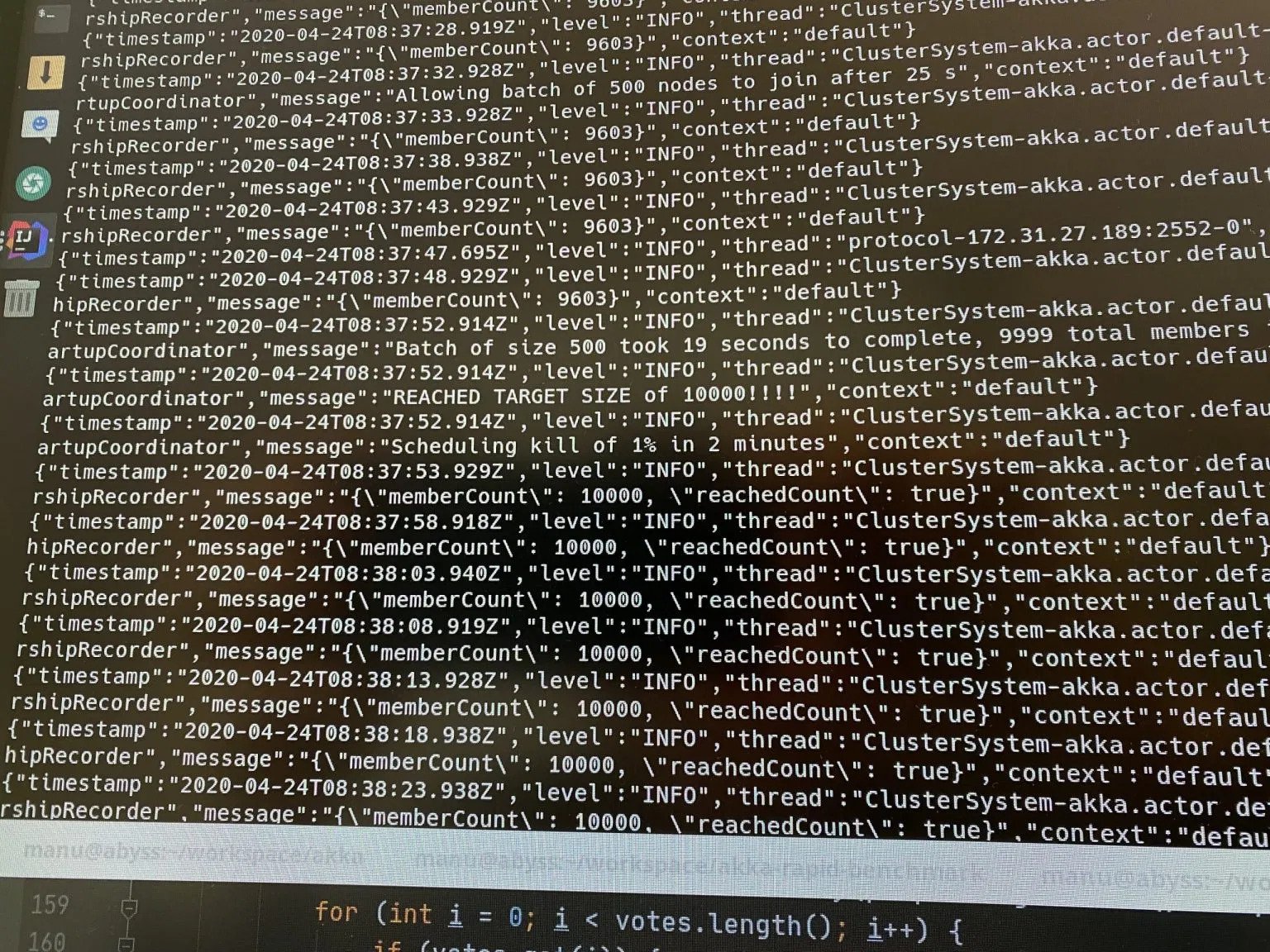This benchmark environment allows to deploy Akka Clusters of arbitrary size. It has been used successfully in order to bootstrap a 10,000 node cluster as described in this article.
It was developed primarily developed for use with the Rapid membership protocol integration of Akka Cluster, but can also be used to bootstrap a regular Akka Cluster.
This project uses Terraform in order to deploy the infrastructure. See deploy/akka-cluster for details.
Depending on the size of the cluster you want to launch, request the appropriate limit increases. For example, for 10k:
- Network interfaces: 10000
- Running On-Demand All Standard (A, C, D, H, I, M, R, T, Z) instances: 40000
In order to bootstrap things faster, those would be nice to have (not sure if AWS will grant them to you though).
RunInstancesRequest Token bucket size: 1000, refill rate 100DescribeInstancesRequest Token bucket size 1000, refill rate 100
Make sure to create 3 subnets that are in the same region and copy their IDs for later.
Make sure that nothing prevents the subnets from communicating with each other, i.e. check the security group settings and other networking rules.
To the very least all 3 subnets need to be able to talk to each other via the ports configured in deploy/ip_tables.sh.
In order to speed up concurrency when creating the infrastructure via terraform, you can use this hack:
git clone git@github.com:manuelbernhardt/terraform-provider-aws.git
cd terraform-provider-aws
git checkout concurrency-hack
make tools
make build- run
terraform initfrom thedeploydirectory of this directory to create the fitting directory structure - copy the resulting artifact from this custom build into the
pluginssubdirectory that works with your architecture, e.g.deploy/.terraform/plugins/linux_amd64.
git clone git@github.com:manuelbernhardt/rapid.git
cd rapid
git checkout ch-broadcaster
mvn installgit clone git@github.com:manuelbernhardt/akka.git
cd akka
git checkout rapid
sbt -Dakka.build.useLocalMavenResolver=true -Dakka.build.scalaVersion=2.13.1
publishLocalIn order to have it tagged properly, you need to update the tag
git tag -d v2.6.4-SNAPSHOT
git add .
git commit -m "Change description"
git tag -a v2.6.4-SNAPSHOT -m "Rapid"
sbt -Dakka.build.useLocalMavenResolver=true -Dakka.build.scalaVersion=2.13.1
publishLocalGenerate a key without passphrase, don't overwrite your default ssh key:
ssh-keygen -t rsa -b 2048 -v
Enter file in which to save the key: /tmp/akka
Enter passphrase (empty for no passphrase): Enter
Enter same passphrase again: Enter
Your identification has been saved in /tmp/akka.
Your public key has been saved in /tmp/akka.pub.
The key fingerprint is: ...
Convert it to PEM:
openssl rsa -in /tmp/akka -outform pem > /home/user/akka.pemAdd it to the SSH agent, useful to ssh into the instances:
ssh-add /home/user/akka.pemCopy the deploy.sh.template script to deploy.sh script and fill in the necessary values.
In order to get logging support, you'll need an elastic.co deployment.
- edit
StartupCoordinator.scalaif necessary and adjust the experimental setup parameters:
val InitialBatchSize = 500
val IncrementalBatchSize = 500
val SpareHostsLimit = 1500
val InitialBatchInterval = 25.seconds
val InitialProgressTimeout = 45.seconds- run the experiment
sh deploy.sh 100 0This will launch a 100 node cluster with 0 broadcasters
Since the EC2 instances will be divided in groups of 3, you need to make sure that num instances - num broadcasters - 1 is divisible by 3.
E.g.
sh deploy.sh 10000 102For a 10000 node cluster with 102 broadcasters
DO NOT FORGET TO DO THIS or else you'll pay for it (quite literally, with your money)
You need to have the aws cli tools installed and all the necessary environment variables set for this to work
sbt
runMain io.bernhardt.akka.rapid.InstanceTerminatorYou can ssh to the seed node and create the /tmp/akka-stop-all file in order to quickly instruct all registered instances to shut down.
Get the hostname of the seed node using:
sbt
runMain io.bernhardt.akka.rapid.SeedNodeAddressThen run:
ssh ubuntu@ec2-...
echo "Stop" > /tmp/akka-stop-allNote that this will only stop the instances, it won't terminate them, don't forget to run the terminator later on.
See the vega visualization in plotting/vega.txt in order to create a Vega visualzation in Kibana.
- comment out the
bashExtraDefinesinbuild.sbt - enable the console appender / disable the file appender in
src/main/resources/logback.xml - run
sh localCluster.sh 50to bootstrap a 50 nodes cluster on your machine. Make sure you have a strong machine
For reference, a 16 core AMD Threadripper with 64 GB of RAM can run clusters up to 200 nodes before it starts bursting into flames.
